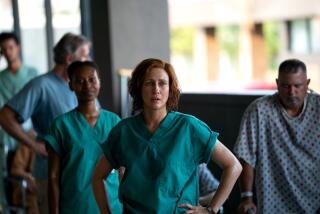DIY ventilator? ‘Weeds’ tries to pull it off
- Share via
“Weeds”: “Mother Thinks the Birds Are After Her” episode; Showtime, June 16.
The premise: Having burned down her house, Nancy Botwin (Mary-Louise Parker) and her family travel to the Mexican border town of Ren Mar, Calif., where they visit Bubbie, the 95-year-old grandmother of Nancy’s dead husband. Bubbie doesn’t answer the door, and the family eventually finds her hooked up to a ventilator and feeding tube. Len (Albert Brooks), Nancy’s former father-in-law, returns after several hours. It is clear that he is the only one taking care of Bubbie. He changes her diaper, turns her and says he will clean her feeding tube soon. He doesn’t adjust or monitor the ventilator despite the fact that the tubes can easily clog and the air pressures are subject to constant change.
The medical questions: How much oversight does a home respirator require in an unresponsive or minimally responsive patient? Is there a need for frequent suctioning every few hours? Does turning the patient only once in several hours increase the risk of decubiti (skin wounds)? Would an aide or a relative be involved in the actual maintaining and monitoring of the feeding tube? Does a comatose patient on a ventilator feel anything? How long can a non-responsive or minimally responsive patient on a ventilator survive in this condition?
The reality: A ventilator is an aggressive, expensive treatment more consistent with hospital intervention than with home use, and a patient facing impending death is unlikely to use one.
“With a home ventilator, there is the need for around-the-clock monitoring by trained personnel as well as a backup power source,” says Dr. David Wallenstein, internist at the UCLA Palliative Care Service. For proper use of a home ventilator, a nurse, nurse’s aide or trained family member must be equipped to deal with emergencies, including mucous plugging or increased airway pressures. The buildup of lung secretions, which occurs as a matter of course, does require frequent suctioning. But less monitoring of the ventilator, even if not medically ideal, can be acceptable in a dying patient if the patient doesn’t seem to be uncomfortable and the family insists on not pulling the plug, says Dr. Joseph Lowy, director of the Palliative Care Service at NYU Langone Medical Center.
Proper care includes turning the patient every few hours, using pillows for supporting the head and back, and cleaning and disinfecting the skin, but it is still very difficult to prevent and treat decubiti in patients such as Bubbie. Even with careful care (which Len is clearly not providing), her skin will continue to deteriorate from the immobility and the difficulty of keeping her well-nourished.
Feeding tubes need to be flushed with water every few hours and periodically need replacement. Bubbie appears to have a gastrostomy tube, a tube inserted through the skin into the stomach that can become clogged, particularly if the tube is also used as a route of administration of medications. An aide or relative must be involved in checking and flushing the tube to keep it from clogging.
Bubbie appears to have suffered severe brain damage, probably the result of a large stroke or anoxic brain injury (lack of oxygen to the brain). These patients “can be maintained unresponsive or minimally responsive on ventilators with tube feedings for years,” says Wallenstein. “But usually such patients are not cared for at home.” This is because of the significant expense and the need for well-trained, devoted caretakers who tend to the patient’s basic needs around the clock.
He adds that patients in Bubbie’s state are likely to be experiencing significant muscular discomfort from immobility. Lowy disagrees, pointing out that the level of discomfort “depends entirely on the level of coma and she may not be feeling anything. The level of coma including response to pain can be determined on a physical examination.”
Finally, a family would have to have exceptional financial resources and motivation to care for Bubbie at home long-term, and Len clearly has neither one.
--
Dr. Marc Siegel is an internist and an associate professor of medicine at New York University’s School of Medicine. He is also the author of “False Alarm: The Truth About the Epidemic of Fear.” In The Unreal World, he explains the medical facts behind the media fiction. He can be reached at marc@doctorsiegel.com.

